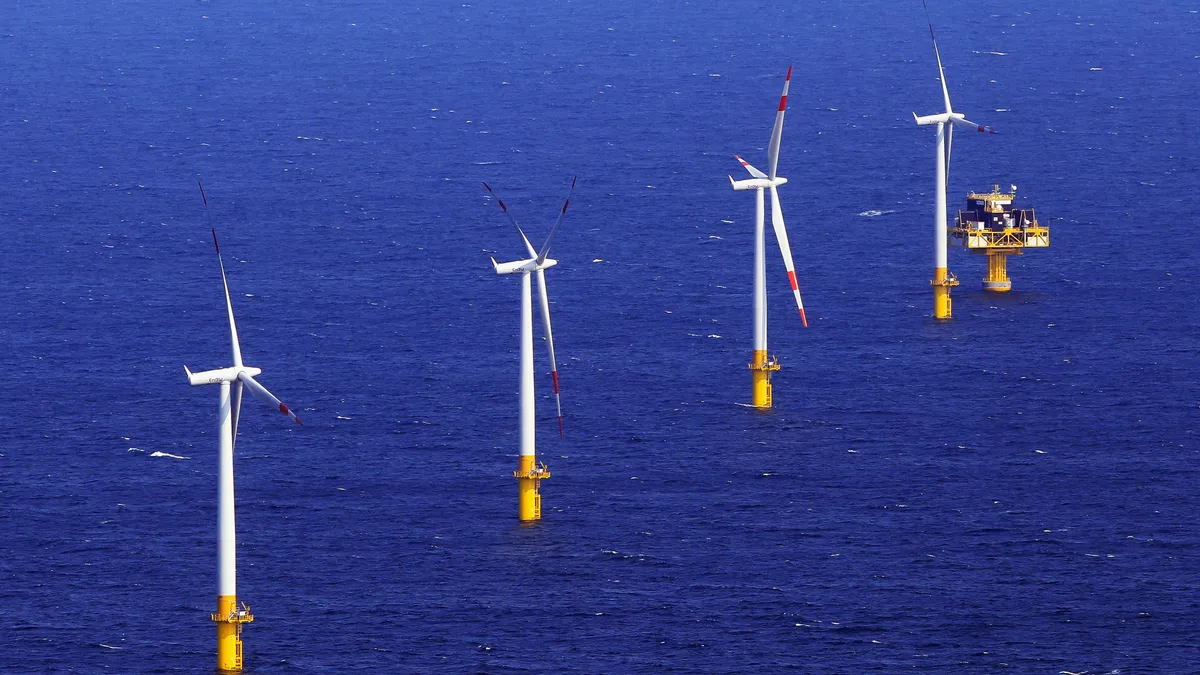Dive Brief:
- The Department of Energy on Wednesday released its Offshore Wind Energy Strategy, outlining goals of deploying 30 GW of offshore wind by 2030 while cutting megawatt hour costs by a third. Additional goals include reaching 15 GW of floating offshore wind deployed by 2035 and 110 GW total deployed by 2050.
- The plan establishes four strategic initiatives that range in focus from immediate needs for lower costs and a secure supply chain, to strategies like co-generation that the U.S. would use to reach full decarbonization.
- DOE said its strategy plan is a “first-of-its-kind, comprehensive summary” of how it plans to support the federal government’s offshore wind goals.
Dive Insight:
The strategy plan was announced by DOE at this year’s International Offshore Wind Partnering Forum in Baltimore.
DOE’s strategy is divided into four categories: NOW, FORWARD, CONNECT and TRANSFORM. NOW focuses on lowering offshore wind costs from $73 per megawatt-hour to $51 per MWh by 2030 and developing a domestic supply chain for the industry.
FORWARD focuses on reducing the cost of floating offshore wind by over 70% to $45 per MWh by 2035 and securing U.S. leadership in the design and manufacturing markets for offshore wind.
CONNECT focuses on finding transmission solutions for large-scale offshore wind projects, and TRANSFORM looks to assist “widespread electrification and decarbonization” using offshore wind co-generation technologies.
“With over 4,200 GW of technical resource potential, offshore wind could meet today’s U.S. electricity demands by more than three times,” DOE says in the report.
Achieving the Biden administration’s goal of 30 GW by 2030 would result in more than 77,300 employed workers in offshore wind jobs, capital investments in offshore wind energy of more than $12 billion a year and five to 10 new manufacturing plants, DOE said.
The report fleshes out which of DOE’s offices will work on each aspect of the strategic initiative. The Wind Energy Technologies Office will work on all aspects across each strategic initiative, while the Office of Science will only work on cost reductions for NOW and FORWARD.
It also proposes more offshore wind deployments in untapped areas such as the Great Lakes, which the report says will be necessary to bring 15 GW of floating wind online by 2035.
“Deployment must extend to deeper waters, which comprise about two-thirds of the U.S. offshore wind energy potential,” DOE says. “This expansion will enable the U.S. West Coast, Gulf of Maine and deeper water areas off all U.S. coasts and the Great Lakes to tap into offshore wind’s energy potential.”
These deployments will pose logistical and regulatory challenges, such as the Great Lakes’ waterways falling under the purview of individual states instead of the Interior Department’s Bureau of Ocean Energy Management, the report says.
DOE’s report also says that the agency recognizes the “critical role” to be played by a wide range of groups including states, developers, regional transmission organizations, tribal nations and manufacturers.
“The rapid pace needed for clean energy deployment requires an inclusive approach that includes participation and partnership among all relevant stakeholders, not just federal agencies,” it says.














